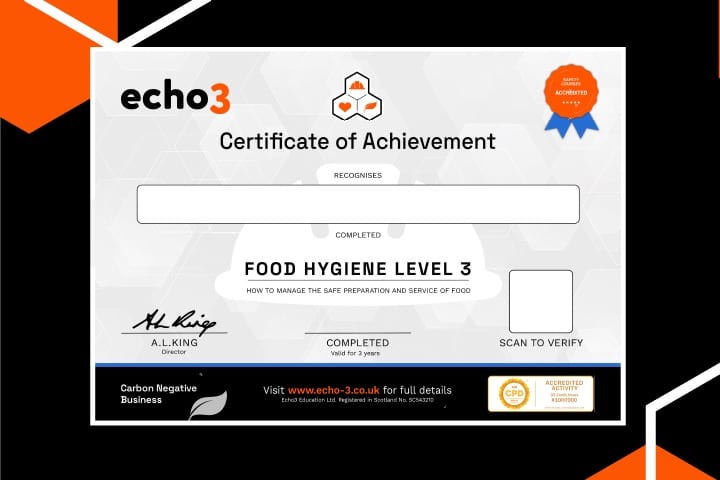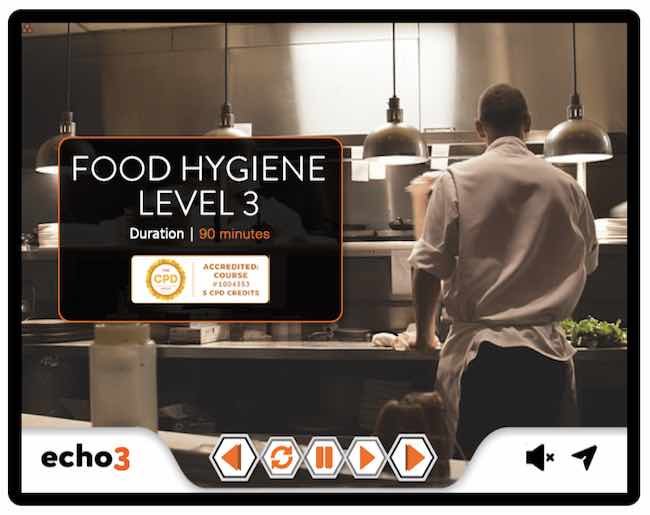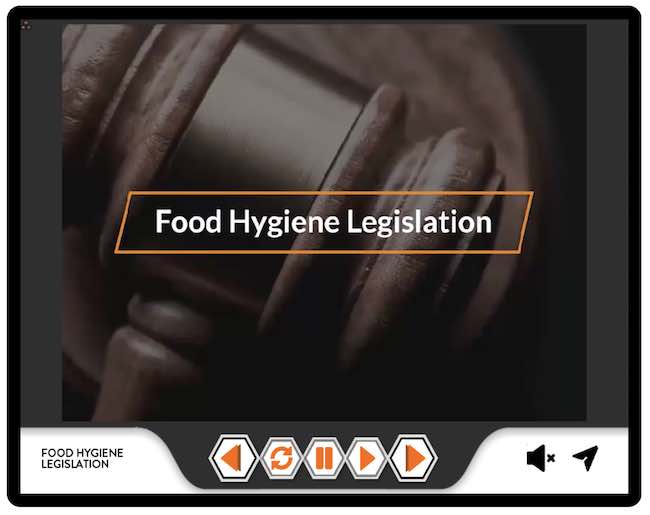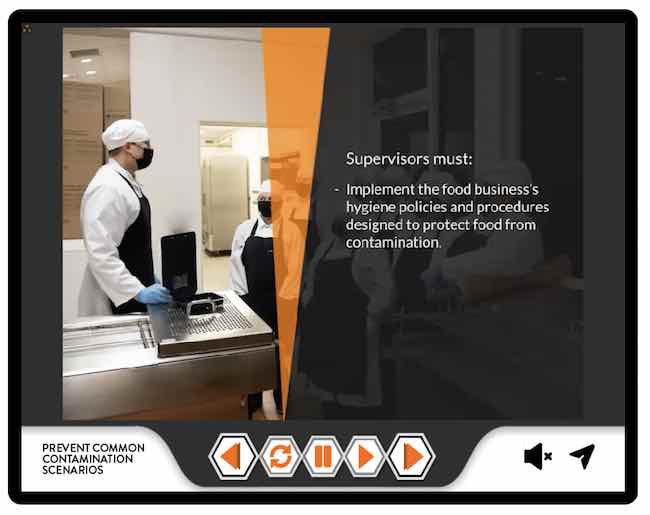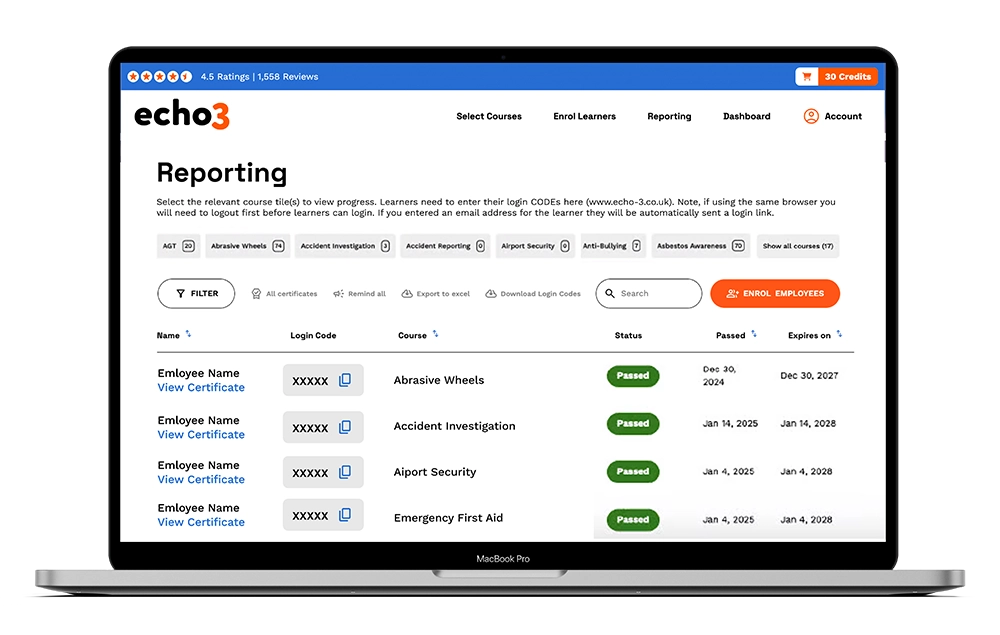Food Hygiene Level 3 Course
The Echo3 online Food Hygiene Level 3 course is specifically designed for individuals in supervisory roles within the food industry, providing the knowledge needed to manage food safety effectively.
Food hygiene refers to the practices and conditions necessary to ensure the safety and cleanliness of food at all stages of production, preparation, storage, and serving. The goal is to prevent foodborne illnesses.
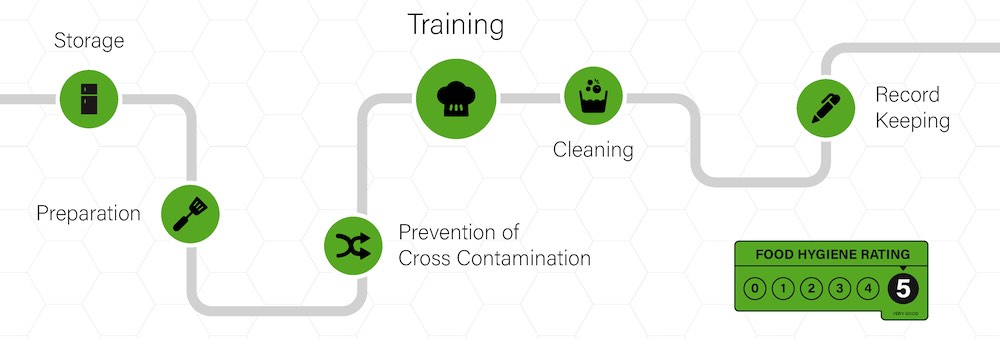
The Food Standards Agency estimates that 1 in 28 people suffer from foodborne illness each year, which can sometimes be fatal. Therefore, food businesses must prioritise food safety, making proper food hygiene training both essential and legally required.
The Echo3 Food Hygiene Level 3 training covers practical steps to manage common hazards, highlighting best practices in personal hygiene, cleaning, cooking, serving, storing, and packaging. Our HACCP Level 3 training, meanwhile, focuses on overall food safety management systems.
If you manage staff handling food, this online Level 3 Food Hygiene training will equip you with the knowledge to ensure your team works safely. For frontline staff, we offer a Level 2 Food Hygiene course.
Food Hygiene Level 3 Course Content
UNIT 1 – Why Food Hygiene Is Important:
This first unit explains the importance of food hygiene by exploring what food hygiene is, the causes and types of food poisoning, identifying high-risk groups, and understanding the key principles necessary to prevent foodborne illnesses.
UNIT 2 – Legislation:
This unit provides an overview of key food hygiene legislation, including the Food Safety Act, general food law, and labelling requirements. It also covers the importance of personal hygiene, the role of enforcement authorities, and concludes with a summary of essential legal responsibilities in food safety.
UNIT 3 – HACCP:
This unit introduces the principles of HACCP (Hazard Analysis and Critical Control Points), focusing on identifying control points, establishing critical limits, and providing a clear summary of how HACCP ensures effective food safety management.
UNIT 4 – Micro-organisms:
This unit explores the various types of micro-organisms that affect food safety, including bacteria, viruses, mould, yeast, and parasites, while also distinguishing between low-risk and high-risk foods.
UNIT 5 – Contamination Hazards and Controls:
This unit examines the different types of contamination hazards, including allergen, physical, and chemical risks, as well as their sources, vehicles, and routes. It also covers how to prevent common contamination scenarios through effective hygiene practices, colour-coding, temperature control, monitoring, and the FIFO (First In, First Out) stock rotation method.
UNIT 6 – Cleaning and Sanitation:
UNIT 7 – Design:
This unit explores the key elements of effective food premises design, including work areas, premises structure, plant and equipment, and essential services. It also covers best practices in storage, distribution and transport, zoning for hygiene control, and waste management to support a safe and efficient food environment.
Food Hygiene Level 3 Course Certificate
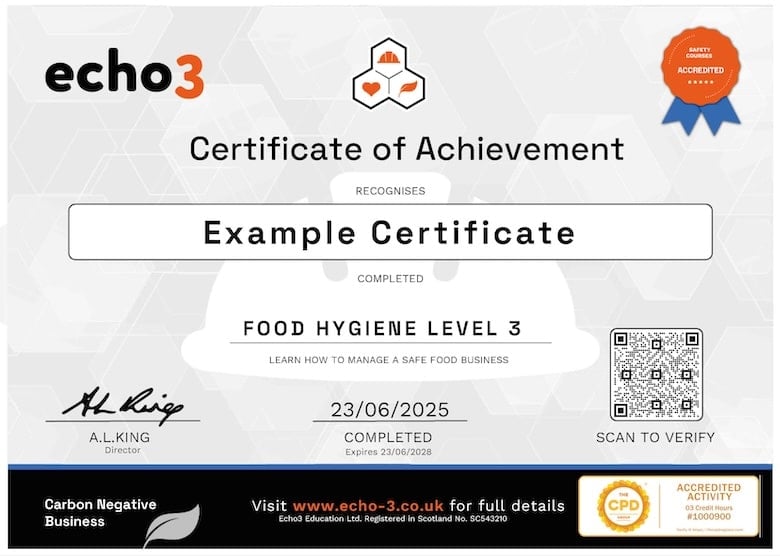
Download and Print Your Certificate
- Written in compliance with Food Safety Guidance
- Developed by qualified health and safety professionals
- Accredited by CPD – learn more about CPD here
- Last Updated June 2024
- To gain the certificate you must complete the assessment which involves 15 questions.
- The online Food Hygiene Level 3 certificate is valid for 3 years.
Course Preview
Echo3 courses include engaging motion-graphic video content, with full english subtitles
Reviews
How to Get Certified in 3 Steps
Individual Learners


Benefits for Individuals
-
Engaging video-based content
-
Learner dashboard included
-
Instant access after payment
-
Free course retakes
-
Shareable digital certificate
 QR Code Certificate
QR Code Certificate




Bulk Buying Discounts
What are the Food Hygiene Level 3 course objectives?
- Provide managers with the knowledge to maintain high food hygiene standards across their team.
- Help food businesses keep consumers safe and meet regulations.
Who should take Echo3 Level 3 Food Hygiene training?
The Echo3 Level 3 Food Hygiene course is appropriate for managers, supervisors, chefs and owners of food various businesses. Including cafes, caterers, restaurants, coffee shops and food manufactures.
What is the difference between ‘level 3’ and ‘level 2’?
Level 2 training is aimed at staff and provides the knowledge to conduct day-to-day activities safely.
Level 3 training is more in-depth and aimed at supervisors, managers and business owners. These courses cover day-to-day activities but also how to periodically evaluate and refine procedures, so they remain appropriate for your workplace.
What is the difference between food hygiene and HACCP training?
Food hygiene training focuses on preventing the contamination of food. Food contamination can take the form of chemical, microbial, physical, and allergenic. A waitstaffs hair is physical contamination. While E.Coli is classed as microbial contamination. Food hygiene training covers practical skills like handwashing that help prevent all types of food contamination.
While HACCP training focusses on the ways to establish a safe food safety management system. This means the way hazards are identified and deciding how risks controlled. HACCP training will require the learner to consider broader issue like workplace design, documentation, scheduling, pest control, supplier management and stock rotation.
Related Courses
Related Courses
HACCP Levels 1&2 – Provides an introduction for staff to the importance of HACCP and the 7 HACCP principles. With this knowledge staff can help ensure only safe food is served.
HACCP Level 3 – Provide managers & supervisors with the knowledge needed to implement & maintain a HACCP-based food safely management system.
Food Hygiene Level 2 – Provides staff with the knowledge needed to adopt safe food handling and hygiene practices.
Food Allergies – Provides staff and managers with the knowledge needed to properly manage allergens.
Preventing Cross-Contamination – Provides the knowledge needed to prevent the cross-contamination of bacteria including E.coli in food businesses.
Temperature Control – Provides the knowledge needed to ensure food is stored at safe, compliant temperatures.
You can easily access all Echo3 courses by purchasing credit.







